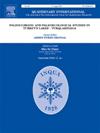青藏高原东北部青海湖天君石林洞陶瓷的发光测年
IF 1.8
3区 地球科学
Q3 GEOGRAPHY, PHYSICAL
引用次数: 0
摘要
古代人类经常在天然洞穴中寻求庇护,以躲避捕食者,并保护自己免受恶劣的环境条件。在青藏高原的许多天然洞穴中,考古调查发现了人类活动的证据。在洞穴遗址中,古代人类活动的年表通常是用光学刺激发光(OSL)测年和加速器质谱(AMS) 14C测年来确定的。然而,考虑到这些洞穴内复杂的沉积环境,获得可靠的结果是具有挑战性的。因此,对不同的材料采用不同的年代测定方法,阐明其对考古遗址年代测定的指示意义是十分必要的。通过比较三种不同的测年方法,对青海湖盆地天君石林洞的古人类活动进行了评估。来自同一地层的AMS 14C测年与陶瓷的OSL测年一致,而OSL测年由于洞穴内矿物的可漂白性较差而高估了年龄。由于人类活动造成了混乱的地层年代学,AMS 14C测年在97 cm深度处显示出年代学反转。因此,陶瓷OSL定年法被用来确定洞穴内人类活动的年龄。通过系统的光光测年,三件陶瓷的年代分别为1.26±0.06 ka、1.14±0.06 ka和1.77±0.12 ka,表明洞穴内的人类活动主要集中在魏晋南北朝至唐代。在地层紊乱的洞穴中,缺乏合适的测年材料,使用陶瓷测年法来确定考古遗址的年龄是首选的。本文章由计算机程序翻译,如有差异,请以英文原文为准。
Luminescence dating on ceramics from the Tianjun Shilin Cave around Qinghai lake in the northeastern Qinghai-Tibet plateau
Ancient humans often sought refuge in natural caves to evade predators and protect themselves from harsh environmental conditions. Archeological investigations have revealed evidence of human activity in numerous natural caves within the Qinghai-Tibet Plateau (QTP). The chronology of ancient human activity at cave sites is typically determined using optically stimulated luminescence (OSL) dating and accelerator mass spectrometry (AMS) 14C dating. However, it is challenging to obtain reliable results considering the complex sedimentary environments within these caves. Therefore, it is imperative to employ various dating methods for different materials and elucidate their indicative significance to determine the age of archeological sites. This study compared three distinct dating methods to assess ancient human activity in the Tianjun Shilin Cave within the Qinghai Lake basin in northeastern QTP. AMS 14C dating from the same stratigraphic layer aligns with OSL dating of the ceramic, while OSL dating overestimated the age owing to poor bleachability of minerals within the cave. Due to human activity creating a disordered stratigraphic chronology, the AMS 14C dating exhibited a chronological reversal at a depth of 97 cm. Consequently, ceramic OSL dating was employed to ascertain the age of human activity within the cave. A systematic OSL dating of the ceramics determined that three ceramics were dated to 1.26 ± 0.06, 1.14 ± 0.06, and 1.77 ± 0.12 ka, indicating that human activity in the cave was predominantly concentrated from the Wei Jin Southern and Northern dynasties through the Tang dynasty. In caves with disturbed strata where suitable dating materials are lacking, the use of ceramic dating is preferred to determine the age of the archeological site.
求助全文
通过发布文献求助,成功后即可免费获取论文全文。
去求助
来源期刊

Quaternary International
地学-地球科学综合
CiteScore
5.60
自引率
4.50%
发文量
336
审稿时长
3 months
期刊介绍:
Quaternary International is the official journal of the International Union for Quaternary Research. The objectives are to publish a high quality scientific journal under the auspices of the premier Quaternary association that reflects the interdisciplinary nature of INQUA and records recent advances in Quaternary science that appeal to a wide audience.
This series will encompass all the full spectrum of the physical and natural sciences that are commonly employed in solving Quaternary problems. The policy is to publish peer refereed collected research papers from symposia, workshops and meetings sponsored by INQUA. In addition, other organizations may request publication of their collected works pertaining to the Quaternary.
 求助内容:
求助内容: 应助结果提醒方式:
应助结果提醒方式:


